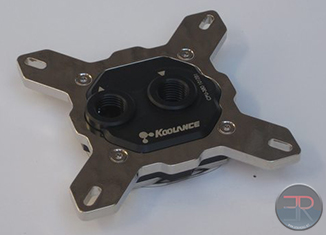Performance Data – Other
Temperatures aren’t everything. For more complex loops with other components, such as GPUs ,
block restriction affects the flow of water and hence performance of these other components.
Here is the flow rate at this fixed pump power setting:
This does not show really block to block restriction well though, as the less restrictive blocks have their flow dominated by other components in the loop. If we look at real pressure drop vs flow curves then we start to see the real spread a little better:
Mount repeatability is also a concern. It is always hard to know without substantially more
data whether a poor result here is truly from the mounting system, the bow of the block or
simply human error. After mounting blocks over 100 times just in this test I’d like to think
I’m not an idiot at it but I’m always willing to be proved wrong. Some blocks such as the
Swiftech Apogee HD and the EK Supremacy do let you bottom out the thumbnuts and so do provide a more reliable mount and this can be seen in the data. In this plot we show the standard
deviation of the thermal performance of each block across the 5 mounts. A higher score is an
indicator of likely poor mount/bow for socket 2011:
Another good indicator of how well a block mounts is to compare it to Indigo Xtreme which we’ll look at in part 2.
Price

The raystorm really does win the value for money award here being priced considerably below the other top performers.
Rotation
Block rotation does sometimes matter. It matters most for blocks that use channels rather than pins because the cpu cores are laid out on the 3930K in a way that favors the block water channels to be lined up vertically when mounted in a “normal atx tower case”. The improvement varies from block to block on the order of 1-3C. See the chart in the port threading section to determine which blocks are correctly aligned by default (horizontal logos/text when in a “normal atx tower case”).
Port Threading
The alphacool could not be recommended because it only had one complete thread on the G 1/4 threads. It should be noted that I did not see any problems with the threading nor do I have the time and tools to do accurate measurements of “likelihood to strip the thread” or “torque to failure”. Alphacool have stood by their design and stated that it meets required specifications however personally I would feel more comfortable with a fully threaded block. Here is a table showing the other blocks and their amount of thread in the ports. It also shows whether the blocks are aligned for maximum performance when mounted with manufacturer’s typeface correctly orientated in a standard atx tower case:
















[…] The CPU block is the Koolance 380 which was the winner in our CPU Block LGA2011 roundup, which you can read about HERE […]
[…] […]
[…] […]
So let me see if I understand, I have a Koolance CPU-380i, in order to obtain the best performance should I put the ports perperdicular to the memory slots (- ||||) or in parallel with the memory slots ( | ||||) ?
the ports should be parallel to ram on SB-E like this pic:
http://koolance.com/image/cache/data/products/cpu-380i_p3-700×700.jpg
(even though this isn’t SB-E, I’ve just started testing on 4770K now)
Have you test it in Ivy Bridge?, Im using the 3770K and I´ve always use my ports perpendicular to ram, I never thought that this could affect performance, do you think it would be the same performance than the haswell 4770K that you start testing?
[…] at CPU blocks on the 4770K. Although we had previously tested blocks on the 3930K during our huge 2012 CPU block roundup we weren’t sure just how well the results would carry over due to the large size difference […]
How much power (in W) does this (CPU – Intel i7-3930K (Unlapped) @ 4.7GHz 1.45Vcore) represent?
Thanks a lot!
[…] our cpu block reviews we often talk about the “rotation” of the block. In the old 2012 roundup we defined the blocks as not rotated or rotated 90 degrees, without really showing evidence of […]
[…] a new CPU block from a manufacturer that already has one of the top performing blocks from our 2012 roundup means that we expected awesome results. We weren’t the only ones – EK warned us to […]
[…] As can be seen the best orientation of the Apogee XL is essentially the same as the older Apogee HD. We only tested one rotation of the Apogee HD because it is a diagonally symmetric block. While there will be slight performance differences in rotation, all four rotations must be tested and that’s just silly. For more details on the Apogee HD it was featured in the 2012 CPU block roundup. […]
[…] announced the long awaited Version 4 of their Heatkiller CPU block. The V3 did very well in our 2012 CPU block roundup despite being quite old still at the time. The official press release isn’t quite ready yet […]
[…] been around for a long long time. In fact it was an older design when we first tested it in our 2012 CPU water block roundup. It did respectably in that roundup given that it was an older design and as newer blocks launched […]
Comments are closed.